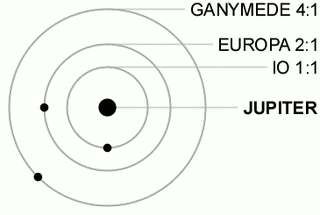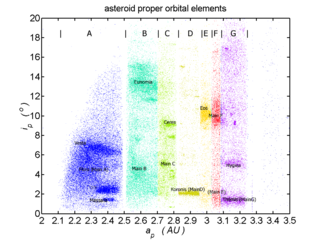
In celestial mechanics, orbital resonance occurs when orbiting bodies exert regular, periodic gravitational influence on each other, usually because their orbital periods are related by a ratio of small integers. Most commonly, this relationship is found between a pair of objects. The physical principle behind orbital resonance is similar in concept to pushing a child on a swing, whereby the orbit and the swing both have a natural frequency, and the body doing the "pushing" will act in periodic repetition to have a cumulative effect on the motion. Orbital resonances greatly enhance the mutual gravitational influence of the bodies. In most cases, this results in an unstable interaction, in which the bodies exchange momentum and shift orbits until the resonance no longer exists. Under some circumstances, a resonant system can be self-correcting and thus stable. Examples are the 1:2:4 resonance of Jupiter's moons Ganymede, Europa and Io, and the 2:3 resonance between Pluto and Neptune. Unstable resonances with Saturn's inner moons give rise to gaps in the rings of Saturn. The special case of 1:1 resonance between bodies with similar orbital radii causes large solar system bodies to eject most other bodies sharing their orbits; this is part of the much more extensive process of clearing the neighbourhood, an effect that is used in the current definition of a planet.

The asteroid belt is a torus-shaped region in the Solar System, located roughly between the orbits of the planets Jupiter and Mars. It contains a great many solid, irregularly shaped bodies, of many sizes, but much smaller than planets, called asteroids or minor planets. This asteroid belt is also called the main asteroid belt or main belt to distinguish it from other asteroid populations in the Solar System such as near-Earth asteroids and trojan asteroids.

A Kirkwood gap is a gap or dip in the distribution of the semi-major axes of the orbits of main-belt asteroids. They correspond to the locations of orbital resonances with Jupiter.

E-type asteroids are asteroids thought to have enstatite (MgSiO3) achondrite surfaces. They form a large proportion of asteroids inward of the asteroid belt known as Hungaria asteroids, but rapidly become very rare as the asteroid belt proper is entered. There are, however, some that are quite far from the inner edge of the asteroid belt, such as 64 Angelina. They are thought to have originated from the highly reduced mantle of a differentiated asteroid.
Hecuba is a fairly large and bright main-belt asteroid. It was discovered by Karl Theodor Robert Luther on 2 April 1869, and named after Hecuba, wife of King Priam in the legends of the Trojan War in Greek Mythology. This object is orbiting the Sun with a period of 5.83 years and an eccentricity of 0.06. It became the first asteroid discovered to orbit near a 2:1 mean-motion resonance with the planet Jupiter, and is the namesake of the Hecuba group of asteroids.

An asteroid family is a population of asteroids that share similar proper orbital elements, such as semimajor axis, eccentricity, and orbital inclination. The members of the families are thought to be fragments of past asteroid collisions. An asteroid family is a more specific term than asteroid group whose members, while sharing some broad orbital characteristics, may be otherwise unrelated to each other.
The Eos family is a very large asteroid family located in the outer region of the asteroid belt. The family of K-type asteroids is believed to have formed as a result of an ancient catastrophic collision. The family's parent body is the asteroid 221 Eos.
Hungaria is a relatively small asteroid orbiting in the inner asteroid belt. It is an E-type (high-albedo) asteroid. It is the namesake of the Hungaria asteroids, which orbit the Sun on the inside of the 1:4 Kirkwood gap, standing out of the core of the asteroid belt.
The Massalia family is a family of asteroids in the inner asteroid belt, named after its parent body, 20 Massalia. It consists of S-type asteroids with very low inclinations, straddling the 1:2 resonances with Mars. There are more than 6,000 known Massalian asteroids.
A Hecuba-gap asteroid is a member of a dynamical group of resonant asteroids located in the Hecuba gap at 3.27 AU – one of the largest Kirkwood gaps in the asteroid belt, which is considered the borderline separating the outer main belt asteroids from the Cybeles. A Hecuba-gap asteroid stays in a 2:1 mean motion resonance with the gas giant Jupiter, which may gradually perturbe its orbits over a long period until it either intersect with the orbit of Mars or Jupiter itself. Depending on the dynamical stability of an asteroid's orbit in the Hecuba gap, three subgroups have been proposed. These are the marginally unstable Griqua asteroids, with an estimated lifetime of more than 100 million years, the stable Zhongguo asteroids, and an unnamed, strongly unstable population of asteroids with a dynamical lifetime of less than 70 million years.

7604 Kridsadaporn, provisional designation 1995 QY2, is an unusual, carbonaceous asteroid and Mars-crosser on a highly eccentric orbit from the outer regions of the asteroid belt, approximately 12 kilometers (7.5 miles) in diameter. It was discovered on 31 August 1995, by Australian astronomer Robert McNaught at Siding Spring Observatory near Coonabarabran, Australia. Due to its particular orbit, the C-type asteroid belongs to MPC's list of "other" unusual objects, and has been classified as an "asteroid in cometary orbit", or ACO. The asteroid was named in memory of Thai astronomer Kridsadaporn Ritsmitchai.
2169 Taiwan, provisional designation 1964 VP1, is a carbonaceous Astridian asteroid from the central regions of the asteroid belt, approximately 17 kilometers in diameter. It was discovered on 9 November 1964, by astronomers at the Purple Mountain Observatory near Nanking, China. It was named for Taiwan.
3789 Zhongguo, provisional designation 1928 UF, is a resonant asteroid from outermost region of the asteroid belt, approximately 14 kilometers in diameter. It was discovered in 1928 by Chinese astronomer Zhang Yuzhe at the Yerkes Observatory in Williams Bay, Wisconsin, in the United States. Originally named "China", the asteroid became lost and its name was transferred to another asteroid. After its re-discovery in 1986, it was named Zhongguo, which is the Chinese word for "China". The T/Xk-type asteroid is the namesake of the resonant Zhongguo group, located in the asteroid belt's Hecuba gap. It has a short rotation period of 3.8 hours.

The Nicemodel is a scenario for the dynamical evolution of the Solar System. It is named for the location of the Côte d'Azur Observatory—where it was initially developed in 2005—in Nice, France. It proposes the migration of the giant planets from an initial compact configuration into their present positions, long after the dissipation of the initial protoplanetary disk. In this way, it differs from earlier models of the Solar System's formation. This planetary migration is used in dynamical simulations of the Solar System to explain historical events including the Late Heavy Bombardment of the inner Solar System, the formation of the Oort cloud, and the existence of populations of small Solar System bodies such as the Kuiper belt, the Neptune and Jupiter trojans, and the numerous resonant trans-Neptunian objects dominated by Neptune.

The Late Heavy Bombardment (LHB), or lunar cataclysm, is a hypothesized event thought to have occurred approximately 4.1 to 3.8 billion years (Ga) ago, at a time corresponding to the Neohadean and Eoarchean eras on Earth. According to the hypothesis, during this interval, a disproportionately large number of asteroids and comets collided with the early terrestrial planets in the inner Solar System, including Mercury, Venus, Earth and Mars. These came from both post-accretion and planetary instability-driven populations of impactors. Although widely accepted, it remains difficult to prove conclusively.
The five-planet Nice model is a numerical model of the early Solar System that is a revised variation of the Nice model. It begins with five giant planets, the four that exist today plus an additional ice giant between Saturn and Uranus in a chain of mean-motion resonances.

The E-belt asteroids were the population of a hypothetical extension of the primordial asteroid belt proposed as the source of most of the basin-forming lunar impacts during the Late Heavy Bombardment.
The jumping-Jupiter scenario specifies an evolution of giant-planet migration described by the Nice model, in which an ice giant is scattered inward by Saturn and outward by Jupiter, causing their semi-major axes to jump, quickly separating their orbits. The jumping-Jupiter scenario was proposed by Ramon Brasser, Alessandro Morbidelli, Rodney Gomes, Kleomenis Tsiganis, and Harold Levison after their studies revealed that the smooth divergent migration of Jupiter and Saturn resulted in an inner Solar System significantly different from the current Solar System. During this migration secular resonances swept through the inner Solar System exciting the orbits of the terrestrial planets and the asteroids, leaving the planets' orbits too eccentric, and the asteroid belt with too many high-inclination objects. The jumps in the semi-major axes of Jupiter and Saturn described in the jumping-Jupiter scenario can allow these resonances to quickly cross the inner Solar System without altering orbits excessively, although the terrestrial planets remain sensitive to its passage.

In planetary astronomy, the grand tack hypothesis proposes that Jupiter formed at 3.5 AU, then migrated inward to 1.5 AU, before reversing course due to capturing Saturn in an orbital resonance, eventually halting near its current orbit at 5.2 AU. The reversal of Jupiter's planetary migration is likened to the path of a sailboat changing directions (tacking) as it travels against the wind.












